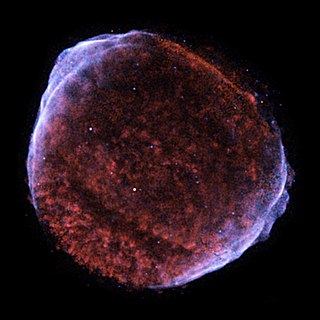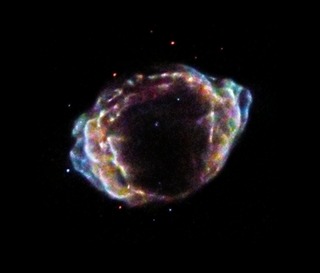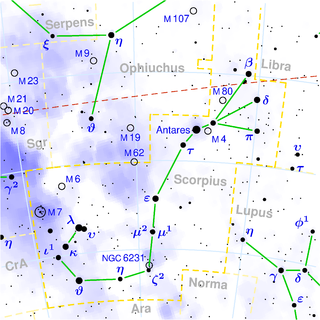External links
- Dave Green's homepage
- Dave Green's "Other Homepage"
- Historical Supernovae and Their Remnants by D.A. Green and F.R. Stephenson
- Dave Green Facts
- Dave Green's cubehelix colour scheme
David A. Green | |
|---|---|
| Born | 1959 (age 64–65) |
| Nationality | British |
| Alma mater | University of Cambridge |
| Scientific career | |
| Fields | Astrophysics |
| Institutions | Cavendish Laboratory |
| Doctoral advisor | Stephen Gull |
Dave Green (born 1959) is an astrophysicist at the Cavendish Laboratory in Cambridge, UK and University Senior Lecturer at the University of Cambridge. He is also a Fellow of Churchill College, where he a Director of Studies for Physics. His research focuses on supernova remnants (SNRs), including studies of G1.9+0.3 the youngest Galactic SNR yet identified, and he has written a book on the historical supernovae along with F. Richard Stephenson. He designed the cubehelix colour scheme for intensity images.

A supernova is a powerful and luminous explosion of a star. A supernova occurs during the last evolutionary stages of a massive star, or when a white dwarf is triggered into runaway nuclear fusion. The original object, called the progenitor, either collapses to a neutron star or black hole, or is completely destroyed to form a diffuse nebula. The peak optical luminosity of a supernova can be comparable to that of an entire galaxy before fading over several weeks or months.

SN 1604, also known as Kepler's Supernova, Kepler's Nova or Kepler's Star, was a Type Ia supernova that occurred in the Milky Way, in the constellation Ophiuchus. Appearing in 1604, it is the most recent supernova in the Milky Way galaxy to have been unquestionably observed by the naked eye, occurring no farther than 6 kiloparsecs from Earth. Before the adoption of the current naming system for supernovae, it was named for Johannes Kepler, the German astronomer who described it in De Stella Nova.

A supernova remnant (SNR) is the structure resulting from the explosion of a star in a supernova. The supernova remnant is bounded by an expanding shock wave, and consists of ejected material expanding from the explosion, and the interstellar material it sweeps up and shocks along the way.

The Crab Nebula is a supernova remnant and pulsar wind nebula in the constellation of Taurus. The common name comes from a drawing that somewhat resembled a crab with arms produced by William Parsons, 3rd Earl of Rosse, in 1842 or 1843 using a 36-inch (91 cm) telescope. The nebula was discovered by English astronomer John Bevis in 1731. It corresponds with a bright supernova recorded by Chinese astronomers in 1054 as a guest star. The nebula was the first astronomical object identified that corresponds with a historically-observed supernova explosion.

First observed between August 4 and August 6, 1181, Chinese and Japanese astronomers recorded the supernova now known as SN 1181 in eight separate texts. One of only five supernovae in the Milky Way confidently identified in pre-telescopic records, it appeared in the constellation Cassiopeia and was visible and motionless against the fixed stars for 185 days. F. R. Stephenson first recognized that the 1181 AD "guest star" must be a supernova, because such a bright transient that lasts for 185 days and does not move in the sky can only be a galactic supernova.

SN 1006 was a supernova that is likely the brightest observed stellar event in recorded history, reaching an estimated −7.5 visual magnitude, and exceeding roughly sixteen times the brightness of Venus. Appearing between April 30 and May 1, 1006, in the constellation of Lupus, this "guest star" was described by observers across China, Japan, modern-day Iraq, Egypt, and Europe, and was possibly recorded in North American petroglyphs. Some reports state it was clearly visible in the daytime. Modern astronomers now consider its distance from Earth to be about 7,200 light-years or 2,200 parsecs.

SN 1054 is a supernova that was first observed on c. 10 July [O.S. c. 4 July] 1054, and remained visible until c. 12 April [O.S. c. 6 April] 1056.α
F. Richard Stephenson is an Emeritus Professor at the University of Durham, in the Physics department and the East Asian Studies department. His research concentrates on historical aspects of astronomy, in particular analyzing ancient astronomical records to reconstruct the history of Earth's rotation. He has an asteroid named after him: 10979 Fristephenson.

SN 1572, or B Cassiopeiae, was a supernova of Type Ia in the constellation Cassiopeia, one of eight supernovae visible to the naked eye in historical records. It appeared in early November 1572 and was independently discovered by many individuals.

W49B is a nebula in Westerhout 49 (W49). The nebula is a supernova remnant, probably from a type Ib or Ic supernova that occurred around 1,000 years ago. It may have produced a gamma-ray burst and is thought to have left a black hole remnant.

A Type Ia supernova is a type of supernova that occurs in binary systems in which one of the stars is a white dwarf. The other star can be anything from a giant star to an even smaller white dwarf.
Dan Milisavljevic is a Canadian astronomer and assistant professor of physics and astronomy at Purdue University.

The known history of supernova observation goes back to 1006 AD. All earlier proposals for supernova observations are speculations with many alternatives.

G1.9+0.3 is a supernova remnant (SNR) in the constellation of Sagittarius. It is the youngest-known SNR in the Milky Way, resulting from an explosion the light from which would have reached Earth some time between 1890 and 1908. The explosion was not seen from Earth as it was obscured by the dense gas and dust of the Galactic Center, where it occurred. The remnant's young age was established by combining data from NASA's Chandra X-ray Observatory and the VLA radio observatory. It was a type Ia supernova. The remnant has a radius of over 1.3 light-years.

De Stella Nova in Pede Serpentarii, generally known as De Stella Nova was a book written by Johannes Kepler between 1605 and 1606, when the book was published in Prague.

SN 393 is the modern designation for a probable supernova that was reported by the Chinese in the year 393 CE. An extracted record of this astronomical event was translated into English as follows:
A guest star appeared within the asterism Wěi during the second lunar month of the 18th year of the Tai-Yuan reign period, and disappeared during the ninth lunar month.
The Green Catalogue of Supernova Remnants lists supernova remnants (SNR) within the Milky Way Galaxy. The catalogue was created in 1984 by Dave Green of Cavendish Laboratory, University of Cambridge. The latest update is the May 2014 version, which lists 294 SNRs.

SN 386 is a probable transient astronomical event in the constellation Sagittarius, which appeared as a "guest star" that was reported by Chinese astronomers in 386 CE.